Metaheuristic Prediction of the Compressive Strength of Environmentally Friendly Concrete Modified with Eggshell Powder Using the Hybrid ANN-SFL Optimization Algorithm
Abstract
1. Introduction
2. Properties of Eggshell Powder
3. Mixing Proportions of Concrete Containing Eggshell Powder
4. Test Results
5. Developing the Model to Estimate Compressive Strength
5.1. Short Description of the Shuffled Frog-Leaping Algorithm (SFLA)
5.2. The Preparation of Training and Testing Data Sets
5.3. Multiple Linear Regression and Genetic Algorithm Models
5.4. Comparison of the Accuracy of Informational Models
6. Concluding Remarks
- The highest slump (12.5 cm) was recorded for the mix design containing 14 and 15% of eggshell powder, while the average slump for the specimens containing 4 to 15% of eggshell powder was 10.5 cm.
- The highest compressive strength was achieved for the mix containing 7 to 9% of eggshell powder (an average of 46 MPa at the age of 28 days); this result is 55% higher than that of the control specimen. However, the lowest compressive strength among the eggshell powder modified concretes was achieved by the mix designs containing 1 and 15% of eggshell powder-34.4 and 30.9 MPa, respectively. Such results are in compliance with those of Yerramala [75], who concluded that a 5% ESP replacement would be optimal for obtaining the maximum compressive strength in concrete.
- Various statistical metrics were deployed to compare the actual compressive strength of eggshell powder modified concrete with the corresponding values predicted by the diverse information models. The results confirmed that the proposed SFLA-ANN model attained the most reliable and robust results for determining the compressive strength of eggshell powder modified concrete.
- The obtained histogram of the test-to-prediction ratios indicated that the SFL-ANN model is better fitted and less dispersed than the other models. Such a result indicates that the proposed information model can achieve a more accurate, safer, and more reliable estimation of the compressive strength of eggshell powder modified concrete.
- It is recommended to compare the life cycle of eggshell powder modified concrete against OPC-based concrete. The boundary of the cradle-to-gate system should be extended to include the mechanical and durability properties of mix designs. By using this approach, not only is the impact of material manufacturing accounted for, but the impacts of service life are also incorporated in the life cycle assessment criteria.
Author Contributions
Funding
Institutional Review Board Statement
Informed Consent Statement
Data Availability Statement
Conflicts of Interest
References
- Miller, S.A.; Moore, F.C. Climate and health damages from global concrete production. Nat. Clim. Chang. 2020, 10, 439–443. [Google Scholar] [CrossRef]
- Sivakrishna, A.; Adesina, A.; Awoyera, P.; Kumar, K.R. Green concrete: A review of recent developments. Mater. Today Proc. 2020, 27, 54–58. [Google Scholar] [CrossRef]
- Habert, G.; Miller, S.; John, V.; Provis, J.; Favier, A.; Horvath, A.; Scrivener, K. Environmental impacts and decarbonization strategies in the cement and concrete industries. Nat. Rev. Earth Environ. 2020, 1, 559–573. [Google Scholar] [CrossRef]
- Hemalatha, T.; Ramaswamy, A. A review on fly ash characteristics–Towards promoting high volume utilization in developing sustainable concrete. J. Clean. Prod. 2017, 147, 546–559. [Google Scholar] [CrossRef]
- Herath, C.; Gunasekara, C.; Law, D.W.; Setunge, S. Performance of high volume fly ash concrete incorporating additives: A systematic literature review. Constr. Build. Mater. 2020, 258, 120606. [Google Scholar] [CrossRef]
- Bheel, N.; Abro, A.W.; Shar, I.A.; Dayo, A.A.; Shaikh, S.; Shaikh, Z.H. Use of rice husk ash as cementitious material in concrete. Eng. Technol. Appl. Sci. Res. 2019, 9, 4209–4212. [Google Scholar] [CrossRef]
- Lo, F.-C.; Lee, M.-G.; Lo, S.-L. Effect of coal ash and rice husk ash partial replacement in ordinary Portland cement on pervious concrete. Constr. Build. Mater. 2021, 286, 122947. [Google Scholar] [CrossRef]
- Mujedu, K.A.; Ab-Kadir, M.A.; Ismail, M. A review on self-compacting concrete incorporating palm oil fuel ash as a cement replacement. Constr. Build. Mater. 2020, 258, 119541. [Google Scholar] [CrossRef]
- Alsubari, B.; Shafigh, P.; Ibrahim, Z.; Alnahhal, M.F.; Jumaat, M.Z. Properties of eco-friendly self-compacting concrete containing modified treated palm oil fuel ash. Constr. Build. Mater. 2018, 158, 742–754. [Google Scholar] [CrossRef]
- Flores, Y.C.; Cordeiro, G.C.; Toledo Filho, R.D.; Tavares, L.M. Performance of Portland cement pastes containing nano-silica and different types of silica. Constr. Build. Mater. 2017, 146, 524–530. [Google Scholar] [CrossRef]
- Rupasinghe, M.; San Nicolas, R.; Mendis, P.; Sofi, M.; Ngo, T. Investigation of strength and hydration characteristics in nano-silica incorporated cement paste. Cem. Concr. Compos. 2017, 80, 17–30. [Google Scholar] [CrossRef]
- Zeyad, A.M.; Khan, A.H.; Tayeh, B.A. Durability and strength characteristics of high-strength concrete incorporated with volcanic pumice powder and polypropylene fibers. J. Mater. Res. Technol. 2020, 9, 806–818. [Google Scholar] [CrossRef]
- Zeyad, A.M.; Tayeh, B.A.; Yusuf, M.O. Strength and transport characteristics of volcanic pumice powder based high strength concrete. Constr. Build. Mater. 2019, 216, 314–324. [Google Scholar] [CrossRef]
- Frhaan, W.K.M.; Abu Bakar, B.; Hilal, N.; Al-Hadithi, A.I. Relation between rheological and mechanical properties on behaviour of self-compacting concrete (SCC) containing recycled plastic fibres: A review. Eur. J. Environ. Civ. Eng. 2020, 25, 1–33. [Google Scholar]
- He, J.; Kawasaki, S.; Achal, V. The utilization of agricultural waste as agro-cement in concrete: A review. Sustainability 2020, 12, 6971. [Google Scholar] [CrossRef]
- Chandra Paul, S.; Mbewe, P.B.; Kong, S.Y.; Šavija, B. Agricultural solid waste as source of supplementary cementitious materials in developing countries. Materials 2019, 12, 1112. [Google Scholar] [CrossRef] [PubMed]
- Hamada, H.M.; Tayeh, B.A.; Al-Attar, A.; Yahaya, F.M.; Muthusamy, K.; Humada, A.M. The present state of the use of eggshell powder in concrete: A review. J. Build. Eng. 2020, 32, 101583. [Google Scholar] [CrossRef]
- Jaber, H.A.; Mahdi, R.S.; Hassan, A.K. Influence of eggshell powder on the Portland cement mortar properties. Mater. Today Proc. 2020, 20, 391–396. [Google Scholar] [CrossRef]
- Vashistha, P.; Kumar, V.; Singh, S.; Dutt, D.; Tomar, G.; Yadav, P. Valorization of paper mill lime sludge via application in building construction materials: A review. Constr. Build. Mater. 2019, 211, 371–382. [Google Scholar] [CrossRef]
- Roslan, N.H.; Ismail, M.; Khalid, N.H.A.; Muhammad, B. Properties of concrete containing electric arc furnace steel slag and steel sludge. J. Build. Eng. 2020, 28, 101060. [Google Scholar] [CrossRef]
- Gaur, A.S.; Kumar, S. Effect of partial replacement of cement by ground-granulated blast-furnace slag and fine aggregate by marble slurry on properties of concrete. Am. J. Eng. Res. 2017, 6, 28–31. [Google Scholar]
- Her, S.; Park, T.; Zalnezhad, E.; Bae, S. Synthesis and characterization of cement clinker using recycled pulverized oyster and scallop shell as limestone substitutes. J. Clean. Prod. 2021, 278, 123987. [Google Scholar] [CrossRef]
- Jhatial, A.A.; Sohu, S.; Memon, M.J.; Bhatti, N.-u.-K.; Memon, D. Eggshell powder as partial cement replacement and its effect on the workability and compressive strength of concrete. Int. J. Adv. Appl. Sci. 2019, 6, 71–75. [Google Scholar]
- Hamada, H.; Tayeh, B.; Yahaya, F.; Muthusamy, K.; Al-Attar, A. Effects of nano-palm oil fuel ash and nano-eggshell powder on concrete. Constr. Build. Mater. 2020, 261, 119790. [Google Scholar] [CrossRef]
- Shekhawat, P.; Sharma, G.; Singh, R.M. Strength behavior of alkaline activated eggshell powder and flyash geopolymer cured at ambient temperature. Constr. Build. Mater. 2019, 223, 1112–1122. [Google Scholar] [CrossRef]
- Brahimi, A.; Meghachou, M.; Abbad, H.; Rahmouni, A.; Belbachir, M. Valorization of Raw Materials Based on Fly Ash of Eggshells and Algerian Sand Dune (Southern West of Algeria) for Synthesis of Environmentally Cementitious Materials: Synthesis and Characterization. Geotech. Geol. Eng. 2020, 38, 1–16. [Google Scholar] [CrossRef]
- Shaikh, F.U.; Supit, S.W. Mechanical and durability properties of high volume fly ash (HVFA) concrete containing calcium carbonate (CaCO3) nanoparticles. Constr. Build. Mater. 2014, 70, 309–321. [Google Scholar] [CrossRef]
- Hemalatha, T.; Mapa, M.; George, N.; Sasmal, S. Physico-chemical and mechanical characterization of high volume fly ash incorporated and engineered cement system towards developing greener cement. J. Clean. Prod. 2016, 125, 268–281. [Google Scholar] [CrossRef]
- Binici, H.; Aksogan, O.; Sevinc, A.H.; Cinpolat, E. Mechanical and radioactivity shielding performances of mortars made with cement, sand and egg shells. Constr. Build. Mater. 2015, 93, 1145–1150. [Google Scholar] [CrossRef]
- Ashok, C.; Chakra, C.S.; Dayakar, T.; Kumar, M.K.; Rao, K.V. Calcium oxide nano particles synthesized from chicken egg shells by physical method. In International Conference Emerging Technologies in Mechanical Sciences; Malla Reddy College of Engineering and Technology: Hyderabad, India, 2014; pp. 72–75. [Google Scholar]
- Pliya, P.; Cree, D. Limestone derived eggshell powder as a replacement in Portland cement mortar. Constr. Build. Mater. 2015, 95, 1–9. [Google Scholar] [CrossRef]
- Oluwatuyi, O.E.; Adeola, B.O.; Alhassan, E.A.; Nnochiri, E.S.; Modupe, A.E.; Elemile, O.O.; Obayanju, T.; Akerele, G. Ameliorating effect of milled eggshell on cement stabilized lateritic soil for highway construction. Case Stud. Constr. Mater. 2018, 9, e00191. [Google Scholar] [CrossRef]
- Tchakouté, H.; Tchinda Mabah, D.; Henning Rüscher, C.; Kamseu, E.; Andreola, F.; Bignozzi, M.; Leonelli, C. Preparation of low-cost nano and microcomposites from chicken eggshell, nano-silica and rice husk ash and their utilisations as additives for producing geopolymer cements. J. Asian Ceram. Soc. 2020, 8, 149–161. [Google Scholar] [CrossRef]
- Jhatial, A.A.; Goh, W.I.; Mo, K.H.; Sohu, S.; Bhatti, I.A. Green and sustainable concrete—The potential utilization of rice husk ash and egg shells. Civ. Eng. J. 2019, 5, 74–81. [Google Scholar] [CrossRef]
- Amu, O.; Fajobi, A.; Oke, B. Effect of eggshell powder on the stabilizing potential of lime on an expansive clay soil. Res. J. Agric. Biol. Sci. 2005, 1, 80–84. [Google Scholar] [CrossRef]
- Nandhini, K.; Karthikeyan, J. Influence of Industrial and Agricultural by-Products as Cementitious Blends in Self-Compacting Concrete–A Review. Silicon 2021, 13, 1–22. [Google Scholar]
- Madani, H.; Kooshafar, M.; Emadi, M. Compressive Strength Prediction of Nanosilica-Incorporated Cement Mixtures Using Adaptive Neuro-Fuzzy Inference System and Artificial Neural Network Models. Pract. Period. Struct. Des. Constr. 2020, 25, 04020021. [Google Scholar] [CrossRef]
- Ahmad, A.; Chaiyasarn, K.; Farooq, F.; Ahmad, W.; Suparp, S.; Aslam, F. Compressive Strength Prediction via Gene Expression Programming (GEP) and Artificial Neural Network (ANN) for Concrete Containing RCA. Buildings 2021, 11, 324. [Google Scholar] [CrossRef]
- Silva, F.A.; Delgado, J.M.; Cavalcanti, R.S.; Azevedo, A.C.; Guimarães, A.S.; Lima, A.G. Use of Nondestructive Testing of Ultrasound and Artificial Neural Networks to Estimate Compressive Strength of Concrete. Buildings 2021, 11, 44. [Google Scholar] [CrossRef]
- Moradi, M.; Khaleghi, M.; Salimi, J.; Farhangi, V.; Ramezanianpour, A. Predicting the compressive strength of concrete containing metakaolin with different properties using ANN. Measurement 2021, 183, 109790. [Google Scholar] [CrossRef]
- Paji, M.K.; Gordan, B.; Biklaryan, M.; Armaghani, D.J.; Zhou, J.; Jamshidi, M. Neuro-swarm and Neuro-imperialism Techniques to Investigate the Compressive Strength of Concrete Constructed by Freshwater and Magnetic Salty Water. Measurement 2021, 182, 109720. [Google Scholar] [CrossRef]
- Goldaran, R.; Turer, A. Application of acoustic emission for damage classification and assessment of corrosion in pre-stressed concrete pipes. Measurement 2020, 160, 107855. [Google Scholar] [CrossRef]
- Goldaran, R.; Turer, A.; Kouhdaragh, M.; Ozlutas, K. Identification of corrosion in a prestressed concrete pipe utilizing acoustic emission technique. Constr. Build. Mater. 2020, 242, 118053. [Google Scholar] [CrossRef]
- Farooq, F.; Czarnecki, S.; Niewiadomski, P.; Aslam, F.; Alabduljabbar, H.; Ostrowski, K.A.; Śliwa-Wieczorek, K.; Nowobilski, T.; Malazdrewicz, S. A Comparative Study for the Prediction of the Compressive Strength of Self-Compacting Concrete Modified with Fly Ash. Materials 2021, 14, 4934. [Google Scholar] [CrossRef]
- Song, H.; Ahmad, A.; Farooq, F.; Ostrowski, K.; Maślak, M.; Czarnecki, S.; Aslam, F. Predicting the compressive strength of concrete with fly ash admixture using machine learning algorithms. Constr. Build. Mater. 2021, 308, 125021. [Google Scholar] [CrossRef]
- Kostić, S.; Vasović, D. Prediction model for compressive strength of basic concrete mixture using artificial neural networks. Neural Comput. Appl. 2015, 26, 1005–1024. [Google Scholar] [CrossRef]
- Asteris, P.G.; Cavaleri, L.; Ly, H.-B.; Pham, B.T. Surrogate models for the compressive strength mapping of cement mortar materials. Soft Comput. 2021, 25, 6347–6372. [Google Scholar] [CrossRef]
- Tanyildizi, H. Prediction of the strength properties of carbon fiber-reinforced lightweight concrete exposed to the high temperature using artificial neural network and support vector machine. Adv. Civ. Eng. 2018, 2018. [Google Scholar] [CrossRef]
- Liang, C.; Qian, C.; Chen, H.; Kang, W. Prediction of compressive strength of concrete in wet-dry environment by BP artificial neural networks. Adv. Mater. Sci. Eng. 2018, 2018. [Google Scholar] [CrossRef]
- Ghafari, E.; Bandarabadi, M.; Costa, H.; Júlio, E. Prediction of fresh and hardened state properties of UHPC: Comparative study of statistical mixture design and an artificial neural network model. J. Mater. Civ. Eng. 2015, 27, 04015017. [Google Scholar] [CrossRef]
- Chithra, S.; Kumar, S.S.; Chinnaraju, K.; Ashmita, F.A. A comparative study on the compressive strength prediction models for High Performance Concrete containing nano silica and copper slag using regression analysis and Artificial Neural Networks. Constr. Build. Mater. 2016, 114, 528–535. [Google Scholar] [CrossRef]
- Kao, C.-Y.; Shen, C.-H.; Jan, J.-C.; Hung, S.-L. A computer-aided approach to pozzolanic concrete mix design. Adv. Civ. Eng. 2018, 2018. [Google Scholar] [CrossRef]
- Nikoo, M.; Zarfam, P.; Sayahpour, H. Determination of compressive strength of concrete using Self Organization Feature Map (SOFM). Eng. Comput. 2015, 31, 113–121. [Google Scholar] [CrossRef]
- Yuan, Z.; Wang, L.-N.; Ji, X. Prediction of concrete compressive strength: Research on hybrid models genetic based algorithms and ANFIS. Adv. Eng. Softw. 2014, 67, 156–163. [Google Scholar] [CrossRef]
- Heidari, A.; Hashempour, M.; Tavakoli, D. Using of backpropagation neural network in estimation of compressive strength of waste concrete. J. Soft Comput. Civ. Eng. 2017, 1, 54–64. [Google Scholar]
- Cheng, M.-Y.; Firdausi, P.M.; Prayogo, D. High-performance concrete compressive strength prediction using Genetic Weighted Pyramid Operation Tree (GWPOT). Eng. Appl. Artif. Intell. 2014, 29, 104–113. [Google Scholar] [CrossRef]
- Kiani, B.; Gandomi, A.H.; Sajedi, S.; Liang, R.Y. New formulation of compressive strength of preformed-foam cellular concrete: An evolutionary approach. J. Mater. Civ. Eng. 2016, 28, 04016092. [Google Scholar] [CrossRef]
- Hadianfard, M.A.; Jafari, S. Prediction of lightweight aggregate concrete compressive strength using ultrasonic pulse velocity test through gene expression programming. Sci. Iran. 2016, 23, 2506–2513. [Google Scholar] [CrossRef]
- Paul, S.C.; Panda, B.; Garg, A. A novel approach in modelling of concrete made with recycled aggregates. Measurement 2018, 115, 64–72. [Google Scholar] [CrossRef]
- Shariati, M.; Mafipour, M.S.; Ghahremani, B.; Azarhomayun, F.; Ahmadi, M.; Trung, N.T.; Shariati, A. A novel hybrid extreme learning machine–grey wolf optimizer (ELM-GWO) model to predict compressive strength of concrete with partial replacements for cement. Eng. Comput 2020, 36, 1–23. [Google Scholar] [CrossRef]
- Behnood, A.; Golafshani, E.M. Predicting the compressive strength of silica fume concrete using hybrid artificial neural network with multi-objective grey wolves. J. Clean. Prod. 2018, 202, 54–64. [Google Scholar] [CrossRef]
- Bui, D.-K.; Nguyen, T.; Chou, J.-S.; Nguyen-Xuan, H.; Ngo, T.D. A modified firefly algorithm-artificial neural network expert system for predicting compressive and tensile strength of high-performance concrete. Constr. Build. Mater. 2018, 180, 320–333. [Google Scholar] [CrossRef]
- Tsai, H.-C. Predicting strengths of concrete-type specimens using hybrid multilayer perceptrons with center-unified particle swarm optimization. Expert Syst. Appl. 2010, 37, 1104–1112. [Google Scholar] [CrossRef]
- Sadowski, L.; Nikoo, M.; Nikoo, M. Concrete compressive strength prediction using the imperialist competitive algorithm. Comput. Concr. 2018, 22, 355–363. [Google Scholar]
- Behnood, A.; Behnood, V.; Gharehveran, M.M.; Alyamac, K.E. Prediction of the compressive strength of normal and high-performance concretes using M5P model tree algorithm. Constr. Build. Mater. 2017, 142, 199–207. [Google Scholar] [CrossRef]
- Bui, D.T.; Ghareh, S.; Moayedi, H.; Nguyen, H. Fine-tuning of neural computing using whale optimization algorithm for predicting compressive strength of concrete. Eng. Comput 2019, 35, 1–12. [Google Scholar]
- Moayedi, H.; Bui, D.T.; Thi Ngo, P.T. Shuffled frog leaping algorithm and wind-driven optimization technique modified with multilayer perceptron. Appl. Sci. 2020, 10, 689. [Google Scholar] [CrossRef]
- Mohammadi, B.; Linh, N.T.T.; Pham, Q.B.; Ahmed, A.N.; Vojteková, J.; Guan, Y.; Abba, S.; El-Shafie, A. Adaptive neuro-fuzzy inference system coupled with shuffled frog leaping algorithm for predicting river streamflow time series. Hydrol. Sci. J. 2020, 65, 1738–1751. [Google Scholar] [CrossRef]
- Kaveh, A.; Talatahari, S.; Khodadadi, N. Hybrid invasive weed optimization-shuffled frog-leaping algorithm for optimal design of truss structures. Iran. J. Sci. Technol. Trans. Civ. Eng. 2020, 44, 405–420. [Google Scholar] [CrossRef]
- Yadav, V.K.; Yadav, K.K.; Cabral-Pinto, M.; Choudhary, N.; Gnanamoorthy, G.; Tirth, V.; Prasad, S.; Khan, A.H.; Islam, S.; Khan, N.A. The processing of calcium rich agricultural and industrial waste for recovery of calcium carbonate and calcium oxide and their application for environmental cleanup: A review. Appl. Sci. 2021, 11, 4212. [Google Scholar] [CrossRef]
- Mabah, D.E.T.; Tchakouté, H.K.; Rüscher, C.H.; Kamseu, E.; Elimbi, A.; Leonelli, C. Design of low cost semi-crystalline calcium silicate from biomass for the improvement of the mechanical and microstructural properties of metakaolin-based geopolymer cements. Mater. Chem. Phys. 2019, 223, 98–108. [Google Scholar] [CrossRef]
- Daso, A.P.; Okonkwo, J.O.; Jansen, R.; Brandao, J.D.; Kotzé, A. Mercury concentrations in eggshells of the southern ground-hornbill (Bucorvus leadbeateri) and wattled crane (Bugeranus carunculatus) in South Africa. Ecotoxicol. Environ. Saf. 2015, 114, 61–66. [Google Scholar] [CrossRef] [PubMed][Green Version]
- Bashir, A.S.; Manusamy, Y.; Chew, T.L.; Ismail, H.; Ramasamy, S. Mechanical, thermal, and morphological properties of (eggshell powder)-filled natural rubber latex foam. J. Vinyl Addit. Technol. 2017, 23, 3–12. [Google Scholar] [CrossRef]
- Babu, T.R.; Neeraja, D. A experimental study of natural admixture effect on conventional concrete and high volume class F flyash blended concrete. Case Stud. Constr. Mater. 2017, 6, 43–62. [Google Scholar] [CrossRef]
- Li, Y.; Xin, S.; Bian, Y.; Xu, K.; Han, C.; Dong, L. The physical properties of poly (L-lactide) and functionalized eggshell powder composites. Int. J. Biol. Macromol. 2016, 85, 63–73. [Google Scholar] [CrossRef]
- Hunt, J.; VOISEY, P.W.; Thompson, B. Physical properties of eggshells: A comparison of the puncture and compression tests for estimating shell strength. Can. J. Anim. Sci. 1977, 57, 329–338. [Google Scholar] [CrossRef]
- Kamalanathan, P.; Ramesh, S.; Bang, L.; Niakan, A.; Tan, C.; Purbolaksono, J.; Chandran, H.; Teng, W. Synthesis and sintering of hydroxyapatite derived from eggshells as a calcium precursor. Ceram. Int. 2014, 40, 16349–16359. [Google Scholar] [CrossRef]
- ASTM C143/C143 M. Standard Test Method for Slump of Hydraulic-Cement Concrete; ASTM International: West Conshohocken, PA, USA, 2000. [Google Scholar]
- ASTM C39/C39M-21. ASTM C39: Standard Test Method for Compressive Strength of Cylindrical Concrete Specimens; ASTM: Philadelphia, PA, USA, 2001. [Google Scholar]
- Adeli, H. Neural networks in civil engineering: 1989–2000. Comput.-Aided Civ. Infrastruct. Eng. 2001, 16, 126–142. [Google Scholar] [CrossRef]
- Flood, I.; Kartam, N. Neural networks in civil engineering. I: Principles and understanding. J. Comput. Civ. Eng. 1994, 8, 131–148. [Google Scholar] [CrossRef]
- Nikoo, M.; Hadzima-Nyarko, M.; Karlo Nyarko, E.; Nikoo, M. Determining the natural frequency of cantilever beams using ANN and heuristic search. Appl. Artif. Intell. 2018, 32, 309–334. [Google Scholar] [CrossRef]
- Haykin, S. Neural Networks: A Comprehensive Foundation; Cambridge University Press: Cambridge, UK, 2007. [Google Scholar]
- Bishop, C.M. Pattern Recognition and Machine Learning; Springer: Berlin/Heidelberg, Germany, 2006. [Google Scholar]
- Bowden, G.J.; Dandy, G.C.; Maier, H.R. Input determination for neural network models in water resources applications. Part 1—Background and methodology. J. Hydrol. 2005, 301, 75–92. [Google Scholar] [CrossRef]
- Eusuff, M.; Lansey, K.; Pasha, F. Shuffled frog-leaping algorithm: A memetic meta-heuristic for discrete optimization. Eng. Optim. 2006, 38, 129–154. [Google Scholar] [CrossRef]


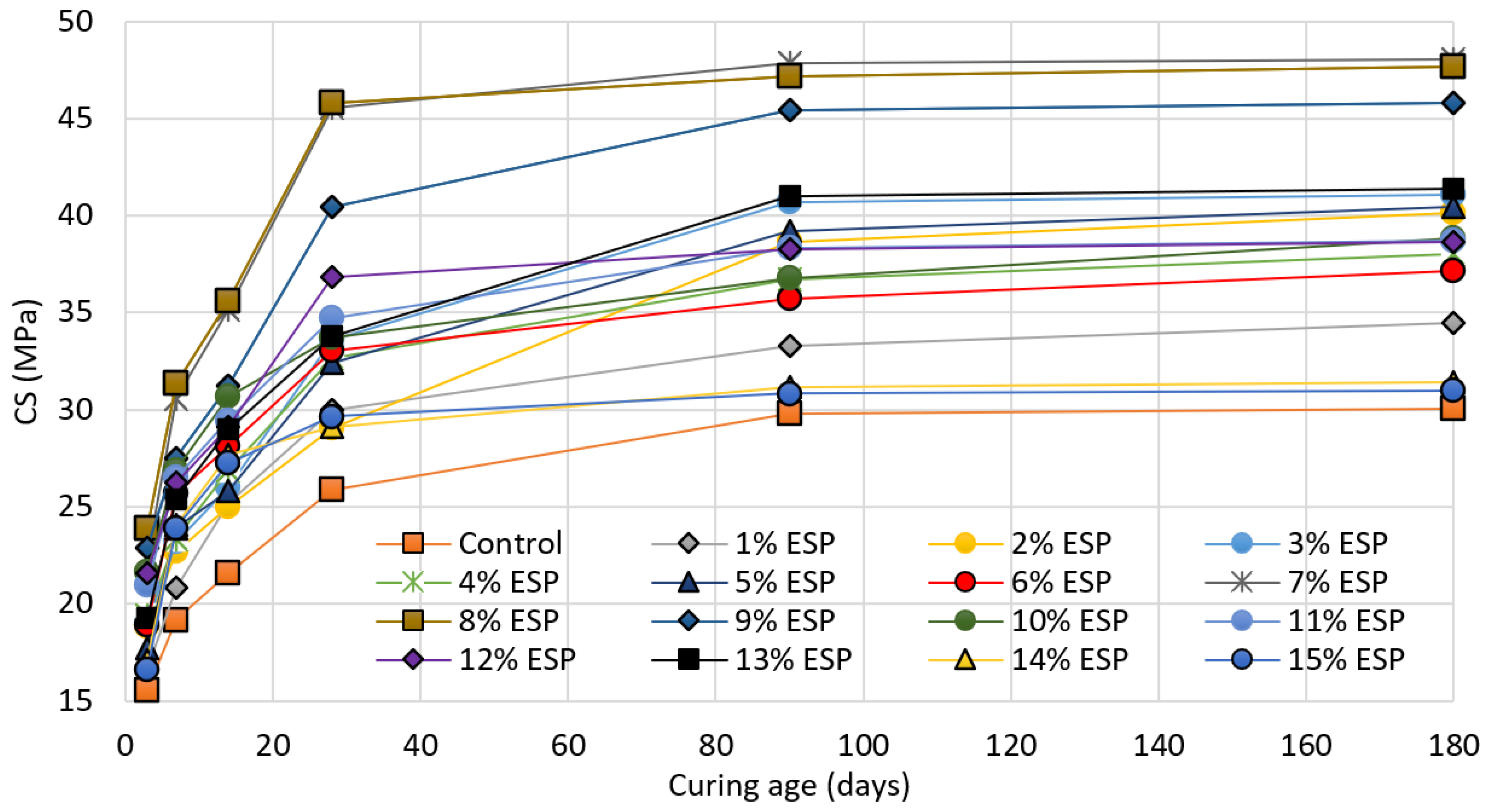

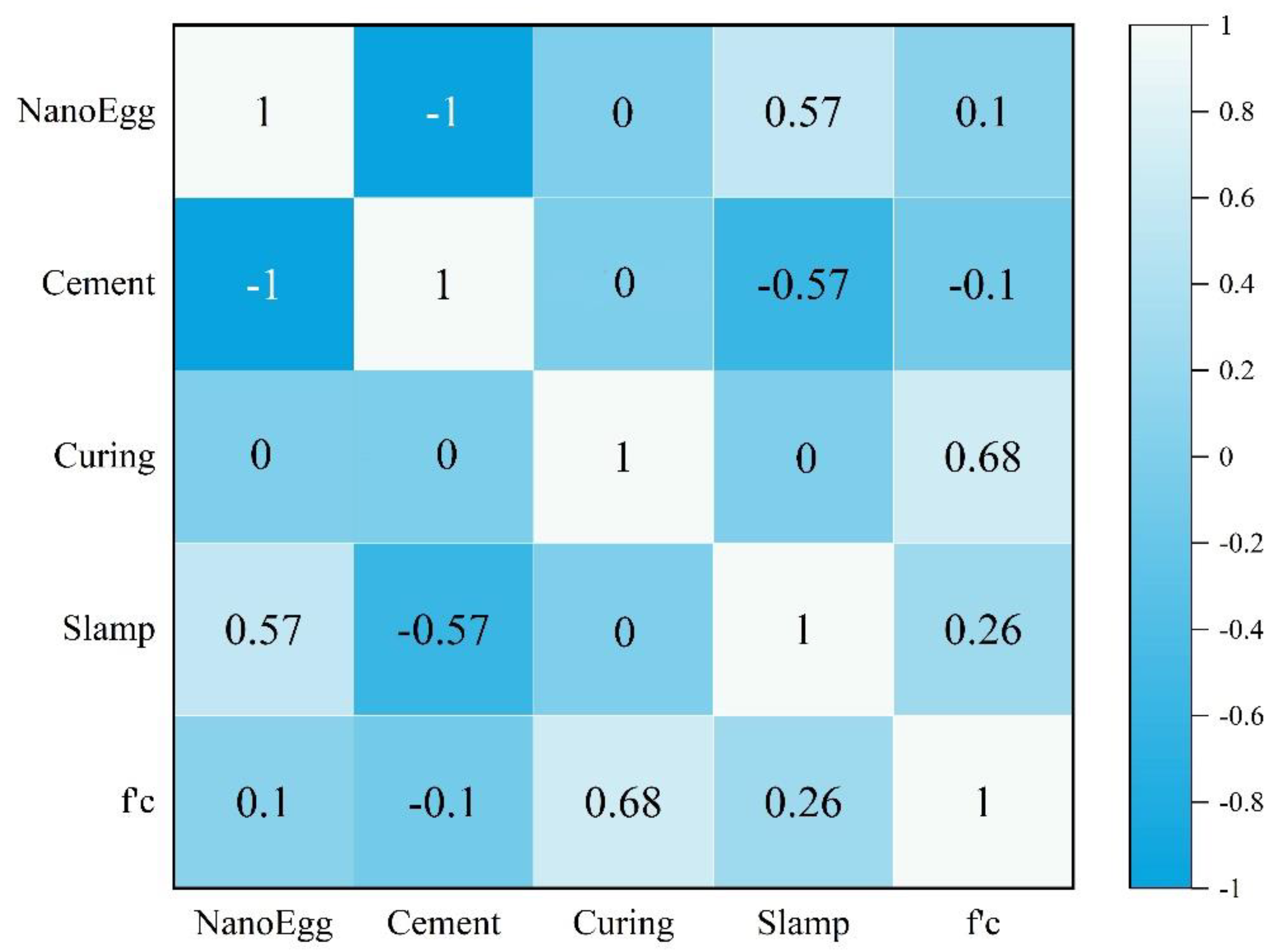
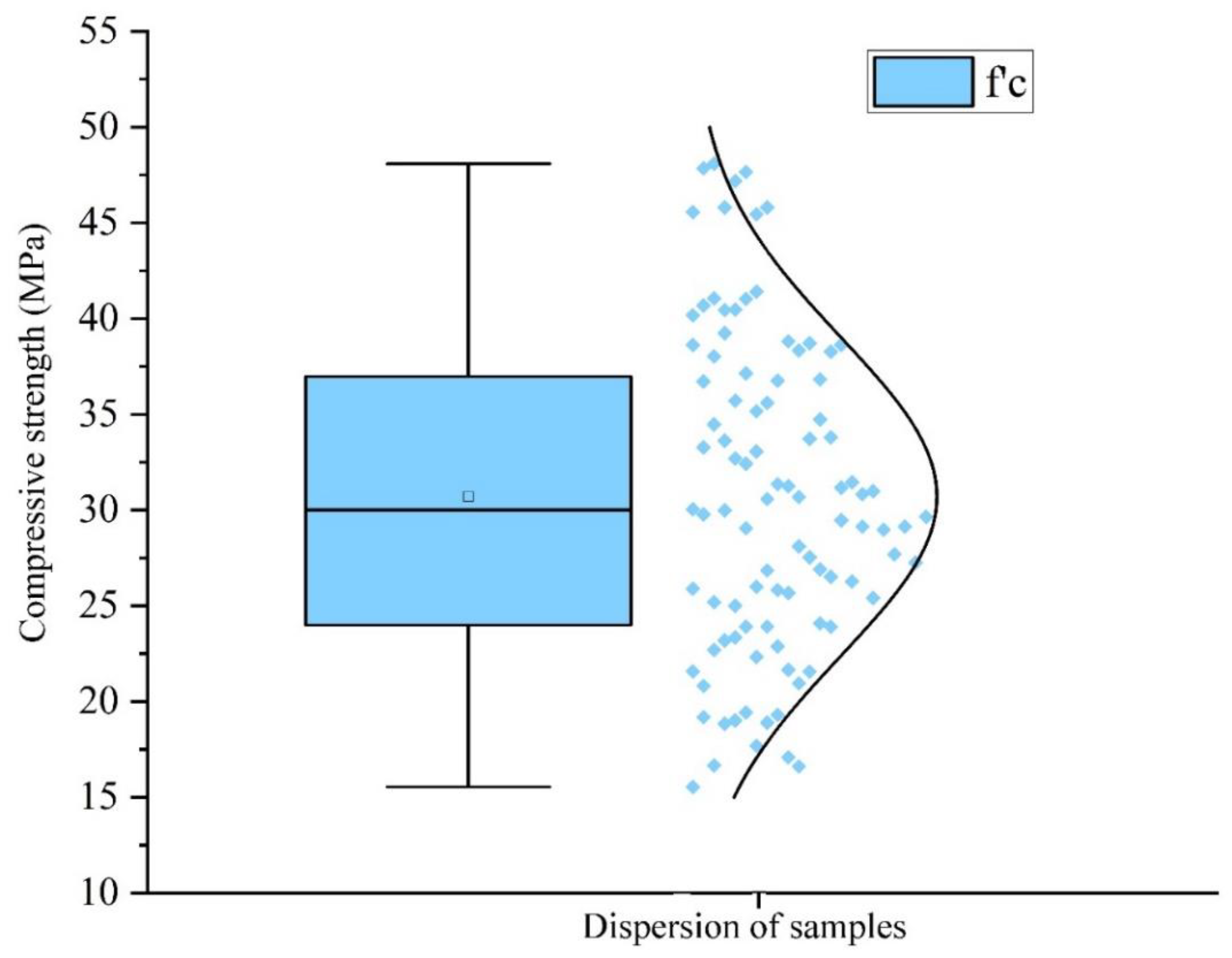
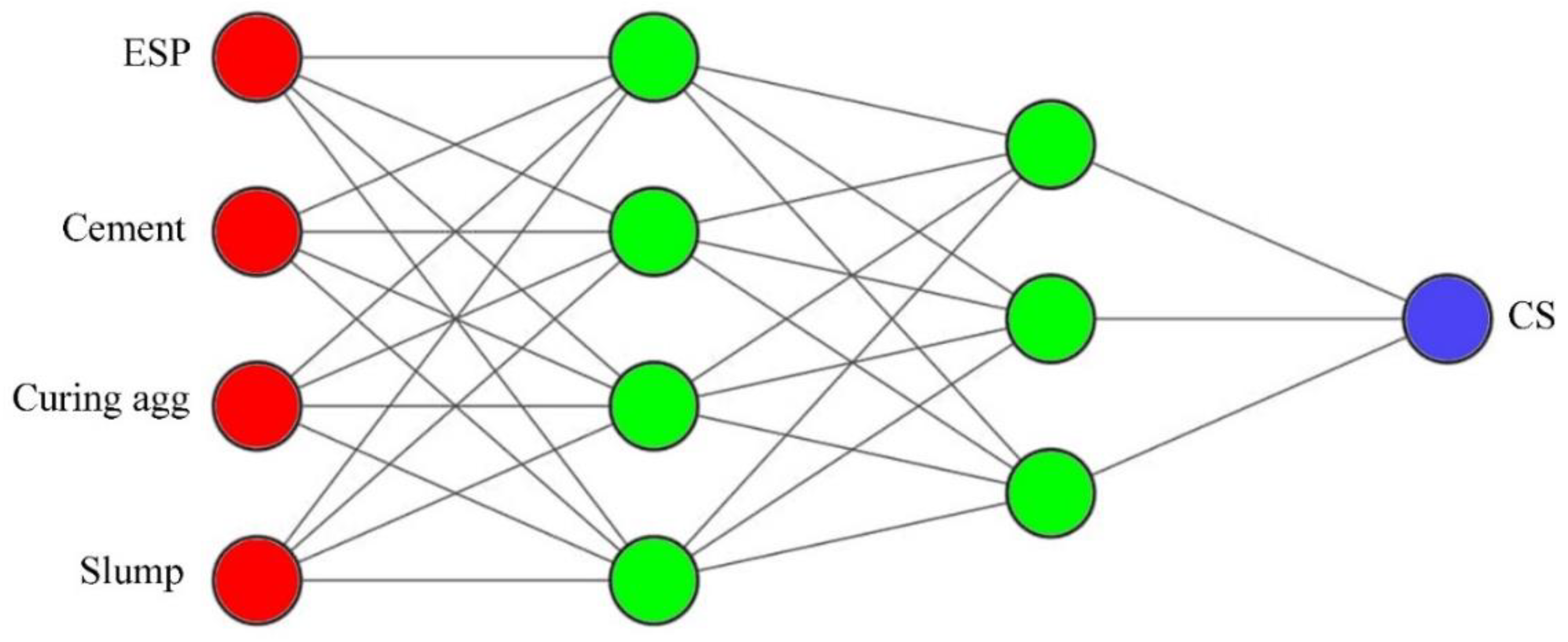
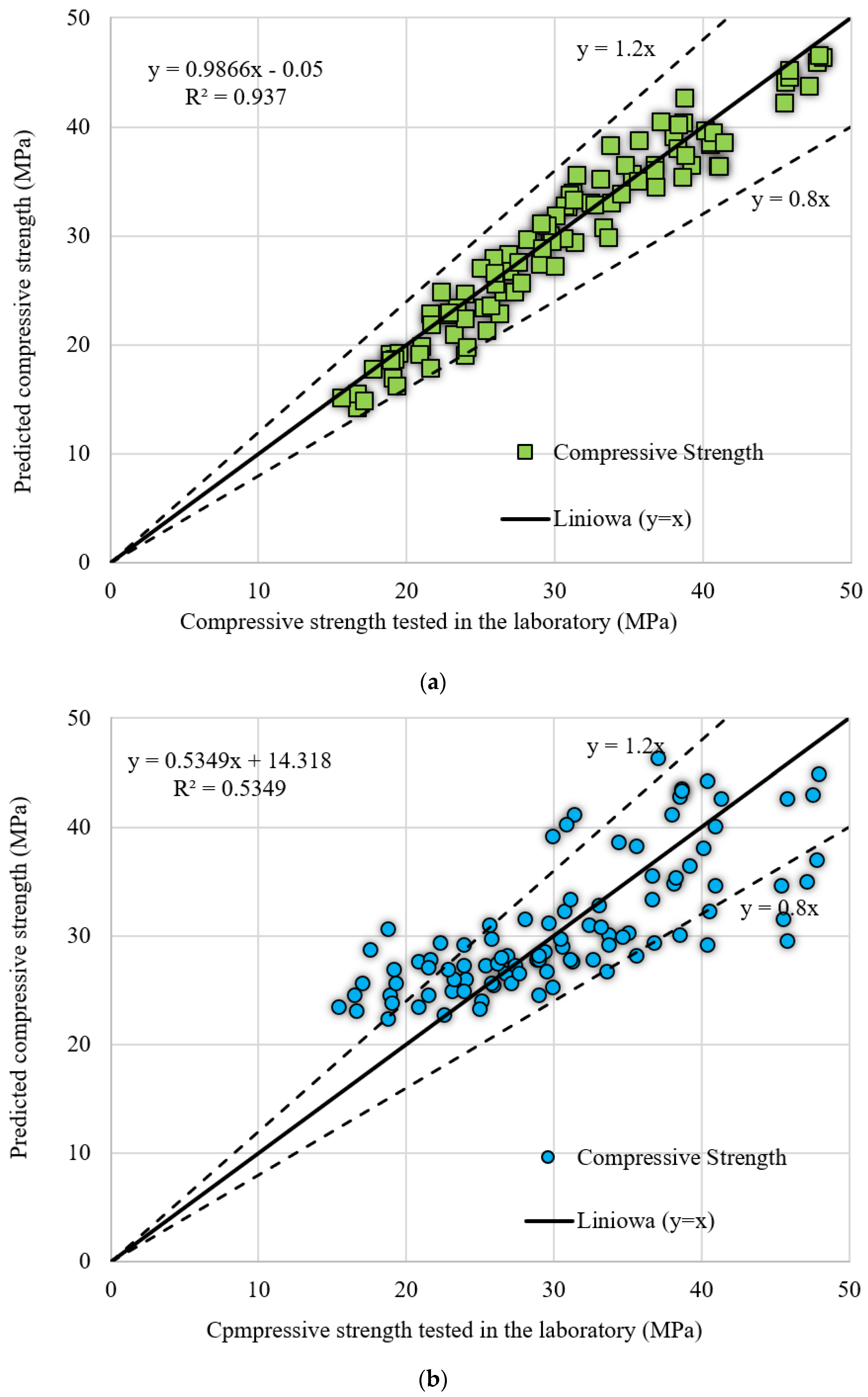
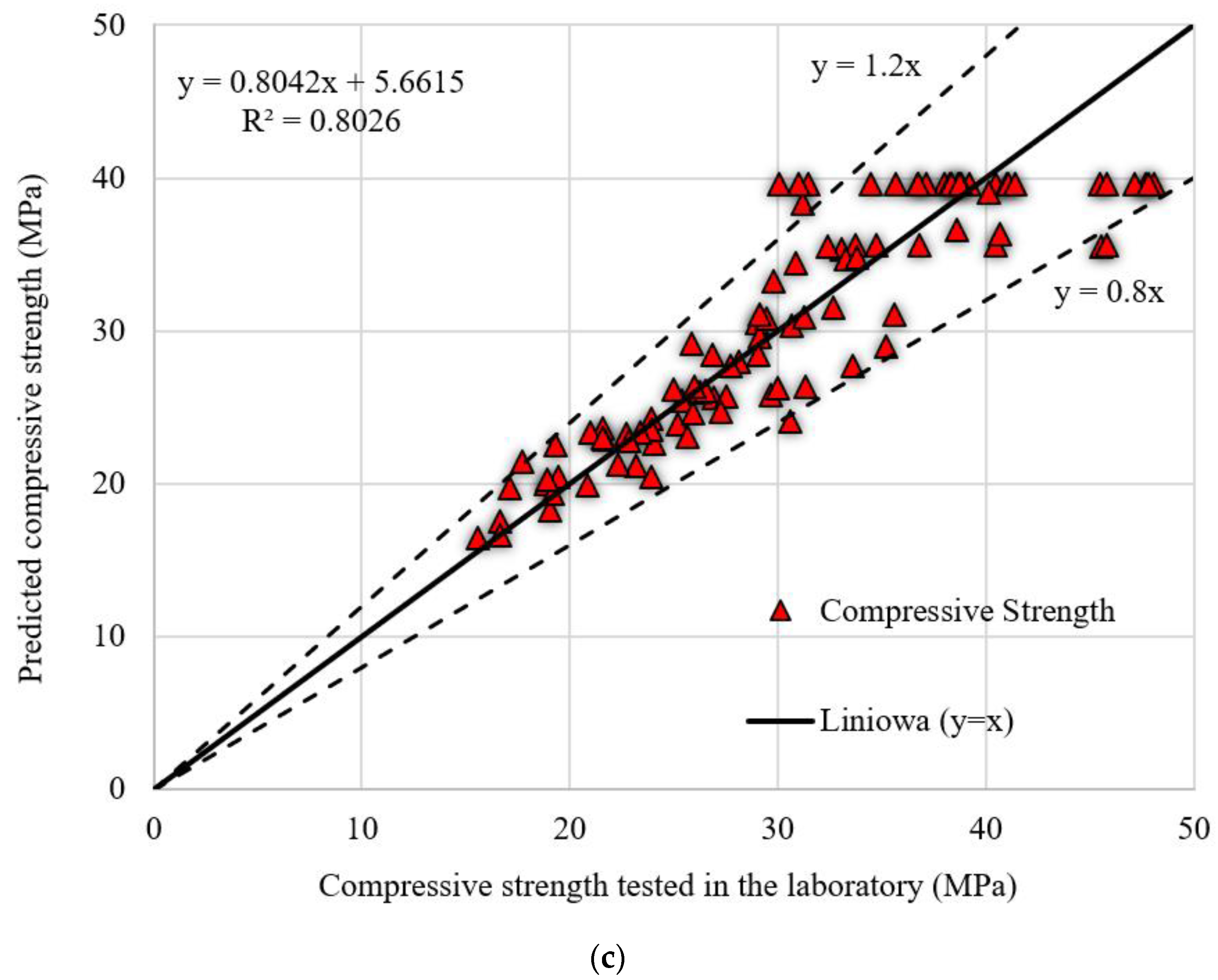

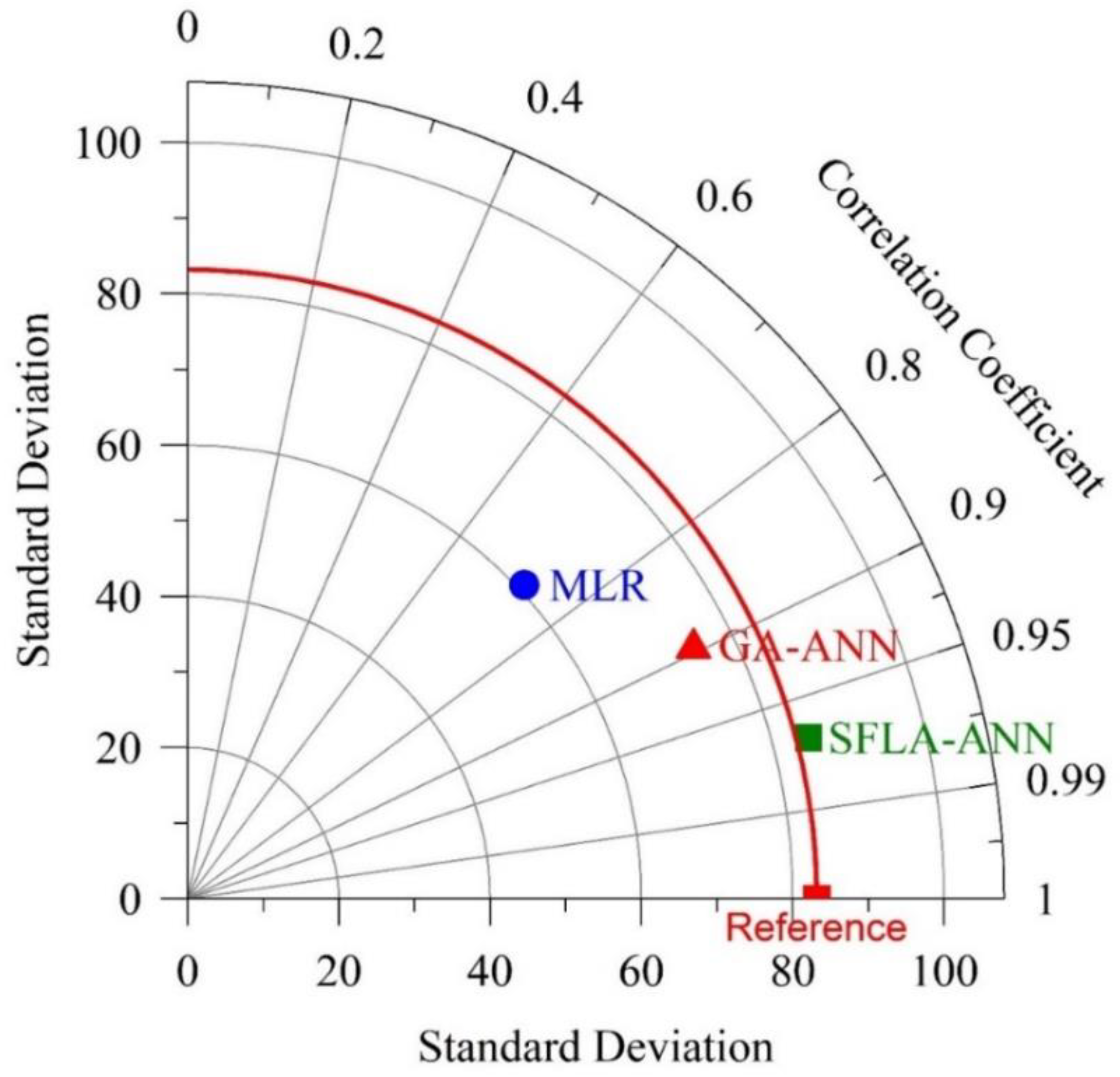
| Type of Learning Algorithm | Admixture and Concrete Feature | |
|---|---|---|
| Below 60 MPa | Over 60 MPa | |
| Levenberg-Marquardt | Kostic and Vasovic (2015) [46]; Basic Concrete Asteris et al. (2021) [47]; Cement Mortar Tanyildizi (2018) [48]; Carbon Fiber-Reinforced Lightweight Concrete Liang et al. (2018) [49]; Basic Concrete | Ghafari et al. (2015) [50]; Ultra High Performance Concrete Chitra et al. (2016) [51]; High Performance Concrete |
| Broyden-Fletcher-Goldfarb-Shanno | Kao et al. (2018) [52]; Pozzolanic Concrete | – |
| Genetic Algorithm | Nikoo et al. (2015) [53]; Basic Concrete Yuan et al. (2014) [54]; Basic Concrete Heidari et al. (2017) [55]; Green Concrete | Cheng et al. (2014) [56]; High Performance Concrete |
| Gene Expression Programming | Kiani et al. (2016) [57]; Preformed-Foam Cellular Concrete Hadianfard and Jafari (2016) [58]; Lightweight Aggregate Concrete | – |
| Bayesian | Paul et al. (2018) [59]; Recycled Aggregate | – |
| Grey Wolves | Mahdi Shariati et al. (2020) [60]; Green Concrete | Behnood et al. (2018) [61]; Silica Fume Concrete |
| Firefly Algorithm | – | Bui et al. (2018) [62]; High Performance Concrete |
| Particle Swarm Optimization | Tsai et al. (2016) [63]; Basic Concrete | – |
| Imperialist Competitive Algorithm | Sadowski et al. (2018) [64]; Basic Concrete | – |
| Model Tree Algorithm | – | Behnood et al. (2017) [65]; High Performance Concrete |
| Whale Optimization Algorithm | Dieu Tien Bui et al. (2019) [66]; Basic Concrete | |
| Compositions | Weight Percentage | Compositions | Weight Percentage |
|---|---|---|---|
| Na2O | 0.32 | MgO | 0.74 |
| S | 0.2 | K2O | 0.06 |
| SrO | 0.2 | SiO2 | 18.09 |
| CaO | 54.89 | P2O5 | 0.31 |
| Fe2O3 | 0.04 |
| Compositions (wt%) | |||
|---|---|---|---|
| CaO | SiO2 | Al2O3 | Fe2O3 |
| 63.8 | 22.1 | 5.0 | 3.0 |
| Mix Design | Cement (kg/m3) | Eggshell Powder (kg/m3) | Fine Aggregate (kg/m3) | Coarse Aggregate (kg/m3) |
|---|---|---|---|---|
| Control | 450 | 0 | 563 | 672 |
| 1 | 445.5 | 4.5 | 563 | 672 |
| 2 | 441 | 9 | 563 | 672 |
| 3 | 436.5 | 13.5 | 563 | 672 |
| 4 | 432 | 18 | 563 | 672 |
| 5 | 427.5 | 22.5 | 563 | 672 |
| 6 | 423 | 27 | 563 | 672 |
| 7 | 418.5 | 31.5 | 563 | 672 |
| 8 | 414 | 36 | 563 | 672 |
| 9 | 409.5 | 40.5 | 563 | 672 |
| 10 | 405 | 45 | 563 | 672 |
| 11 | 400.5 | 49.5 | 563 | 672 |
| 12 | 396 | 54 | 563 | 672 |
| 13 | 391.5 | 58.5 | 563 | 672 |
| 14 | 387 | 63 | 563 | 672 |
| 15 | 382.5 | 67.5 | 563 | 672 |
| Statistical Index | Unit | Type | Max | Min | Average | STD |
|---|---|---|---|---|---|---|
| Eggshell Powder (ESP) Content | kg/m3 | Input | 67.5 | 0.0 | 33.8 | 20.9 |
| Cement Content | kg/m3 | Input | 450.0 | 382.5 | 416.3 | 20.9 |
| Curing Age | Day | Input | 180.0 | 3.0 | 53.7 | 63.9 |
| Slump | cm | Input | 12.5 | 7.3 | 7.9 | 2.9 |
| fc’ | MPa | Output | 48 | 15.5 | 30.7 | 8.3 |
| Num. | Hidden Layer 1 | Hidden Layer 2 | Train | Test | ||||
|---|---|---|---|---|---|---|---|---|
| MSE | AAE | VAF | MSE | AAE | VAF | |||
| 1 | 3 | 3 | 0.005 | 0.002 | 92 | 0.013 | 0.003 | 86 |
| 2 | 3 | 4 | 0.028 | 0.033 | 53 | 0.042 | 0.029 | 53 |
| 3 | 3 | 5 | 0.027 | 0.044 | 55 | 0.042 | 0.037 | 52 |
| 4 | 4 | 3 | 0.006 | 0.013 | 94 | 0.008 | 0.036 | 94 |
| 5 | 4 | 4 | 0.004 | 0.000 | 94 | 0.012 | 0.009 | 87 |
| 6 | 4 | 5 | 0.005 | 0.007 | 92 | 0.014 | 0.009 | 85 |
| 7 | 5 | 3 | 0.027 | 0.038 | 54 | 0.045 | 0.034 | 50 |
| 8 | 5 | 4 | 0.008 | 0.003 | 87 | 0.013 | 0.008 | 86 |
| 9 | 5 | 5 | 0.007 | 0.036 | 90 | 0.018 | 0.026 | 82 |
| 10 | 6 | 3 | 0.026 | 0.039 | 56 | 0.055 | 0.025 | 39 |
| 11 | 6 | 4 | 0.005 | 0.011 | 92 | 0.009 | 0.040 | 92 |
| 12 | 6 | 5 | 0.012 | 0.008 | 81 | 0.031 | 0.031 | 70 |
| Parameter | Value | Parameter | Value |
|---|---|---|---|
| Memeplex Size | 7 | Number of Parents | 2 |
| Number of Memeplexes | 3 | Number of Offspring | 3 |
| Population Size | Memeplex Size × Number of Memeplexes | Maximum Number of Iterations | 5 |
| Parameter | Value |
|---|---|
| Max Generations | 100 |
| Recombination (%) | 15 |
| Lower/Upper Bound | [−1, 1] |
| Crossover (%) | 50 |
| Crossover Method | Single Point |
| Selection Mode | 1 |
| Population Size | 150 |
| Model | Train | Test | All | ||||||||||||
|---|---|---|---|---|---|---|---|---|---|---|---|---|---|---|---|
| Average | STD | COV | AAE | VAF% | Average | STD | COV | AAE | VAF% | Average | STD | COV | AAE | VAF% | |
| SFLA-ANN | 1.01 | 0.07 | 0.07 | 0.01 | 0.94 | 1.04 | 0.08 | 0.08 | 0.03 | 0.94 | 1.02 | 0.07 | 0.07 | 0.06 | 0.93 |
| GA-ANN | 1.00 | 0.114 | 0.11 | 0.08 | 0.77 | 1.03 | 0.09 | 0.09 | 0.06 | 0.90 | 1.01 | 0.11 | 0.1 | 0.08 | 0.80 |
| MLR | 0.99 | 0.17 | 0.18 | 0.14 | 0. 54 | 1.01 | 0.21 | 0.21 | 0.18 | 0.54 | 0.97 | 0.18 | 0.18 | 0.15 | 0.53 |
Publisher’s Note: MDPI stays neutral with regard to jurisdictional claims in published maps and institutional affiliations. |
© 2021 by the authors. Licensee MDPI, Basel, Switzerland. This article is an open access article distributed under the terms and conditions of the Creative Commons Attribution (CC BY) license (https://creativecommons.org/licenses/by/4.0/).
Share and Cite
Tosee, S.V.R.; Faridmehr, I.; Bedon, C.; Sadowski, Ł.; Aalimahmoody, N.; Nikoo, M.; Nowobilski, T. Metaheuristic Prediction of the Compressive Strength of Environmentally Friendly Concrete Modified with Eggshell Powder Using the Hybrid ANN-SFL Optimization Algorithm. Materials 2021, 14, 6172. https://doi.org/10.3390/ma14206172
Tosee SVR, Faridmehr I, Bedon C, Sadowski Ł, Aalimahmoody N, Nikoo M, Nowobilski T. Metaheuristic Prediction of the Compressive Strength of Environmentally Friendly Concrete Modified with Eggshell Powder Using the Hybrid ANN-SFL Optimization Algorithm. Materials. 2021; 14(20):6172. https://doi.org/10.3390/ma14206172
Chicago/Turabian StyleTosee, Seyed Vahid Razavi, Iman Faridmehr, Chiara Bedon, Łukasz Sadowski, Nasrin Aalimahmoody, Mehdi Nikoo, and Tomasz Nowobilski. 2021. "Metaheuristic Prediction of the Compressive Strength of Environmentally Friendly Concrete Modified with Eggshell Powder Using the Hybrid ANN-SFL Optimization Algorithm" Materials 14, no. 20: 6172. https://doi.org/10.3390/ma14206172
APA StyleTosee, S. V. R., Faridmehr, I., Bedon, C., Sadowski, Ł., Aalimahmoody, N., Nikoo, M., & Nowobilski, T. (2021). Metaheuristic Prediction of the Compressive Strength of Environmentally Friendly Concrete Modified with Eggshell Powder Using the Hybrid ANN-SFL Optimization Algorithm. Materials, 14(20), 6172. https://doi.org/10.3390/ma14206172











